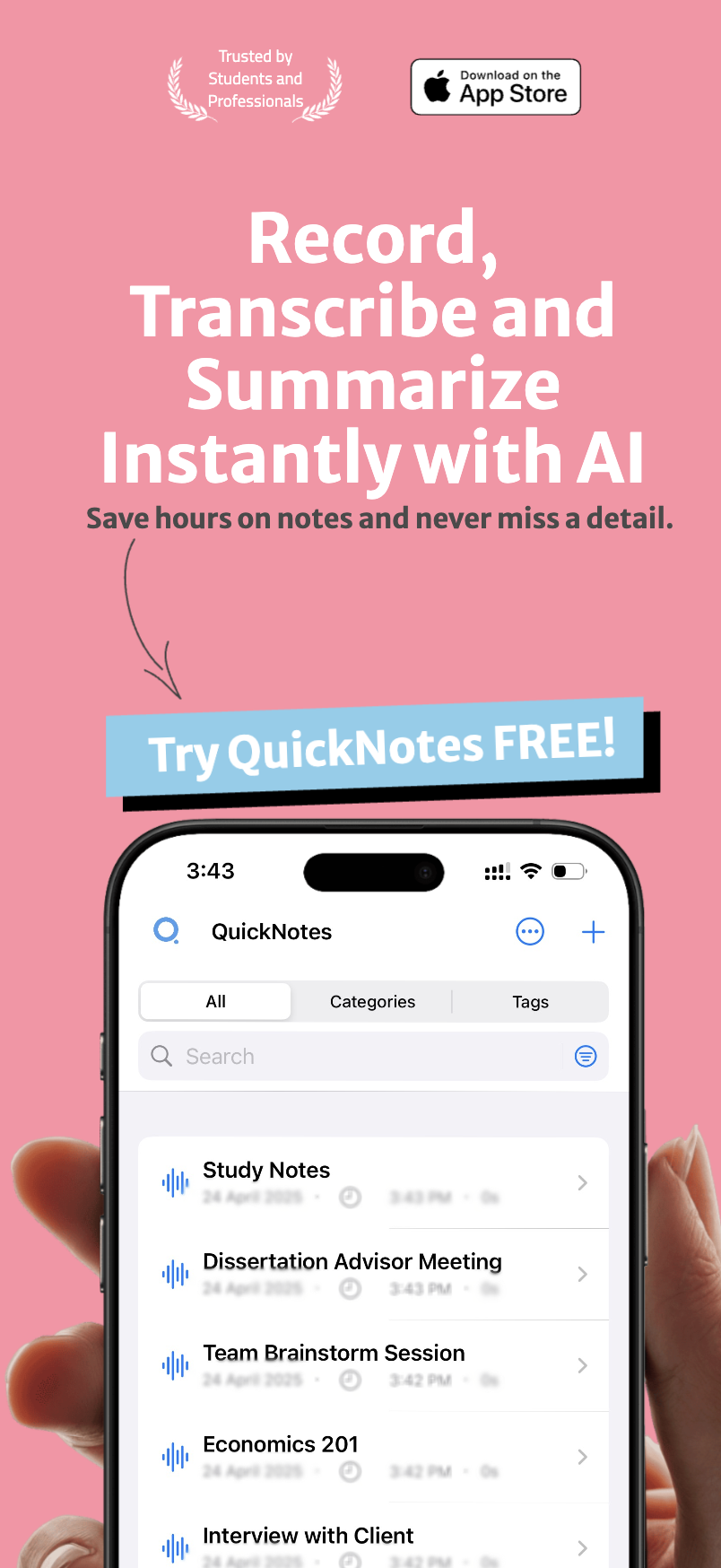Recording lengthy meetings, lectures, or interviews can quickly generate substantial audio files that pose unique challenges for processing and management. When working with large audio recordings in QuickNotes, implementing strategic approaches can significantly improve transcription quality, processing speed, and overall app performance.
Table of Contents
- Understanding the Challenges of Large Audio Files
- Strategic Recording Practices
- Segmented Recording
- Format Selection
- QuickNotes' Chunked Processing Technology
- How Chunked Processing Works
- Optimizing Chunked Processing
- Device Optimization for Large File Processing
- Memory Management
- Power Considerations
- Organizational Strategies for Large Audio Files
- Naming Conventions
- Storage Management Techniques
- Archiving Strategies
- Storage Optimization
- Advanced Tips for Specific Use Cases
- For Academic Lectures
- For Business Meetings
- For Interviews and Research
- Conclusion: Balancing Quality and Efficiency
- You Might Also Like
In this guide, we'll explore practical techniques for efficiently managing and processing large audio files in QuickNotes, helping you maximize transcription accuracy while minimizing processing time and device resource usage.
Understanding the Challenges of Large Audio Files#
Before diving into specific strategies, it's helpful to understand the main challenges that come with processing large audio recordings:
- Increased Processing Time: Longer files require more time to transcribe and summarize
- Higher Memory Usage: Processing large files demands more device resources
- Content Context Challenges: Very long recordings may contain multiple topics that can blur together
- Storage Considerations: Large audio files consume significant storage space
- Battery Consumption: Processing lengthy recordings can drain device batteries quickly
QuickNotes is designed to handle these challenges effectively through its chunked processing approach and optimization features, but understanding how to work with the app for large files can enhance your experience significantly.
Strategic Recording Practices#
The most effective approach to managing large audio files begins before you even start recording:
Segmented Recording#
- Break long sessions into logical segments (e.g., by topic or time intervals)
- Use QuickNotes' pause function rather than stopping and starting new recordings
- Create natural break points that align with content transitions
- Consider 30-45 minute segments for optimal processing efficiency
Format Selection#
- Choose appropriate audio formats based on recording length and quality needs
- Use compressed formats for very long recordings where absolute audio fidelity is less critical
- Select higher quality formats when transcription accuracy is paramount
- Balance quality with file size based on your specific requirements
"I started breaking my three-hour lectures into 45-minute segments in QuickNotes, and not only did processing become faster, but the resulting transcriptions were more accurate and easier to navigate." — Professor James Harrington, Economics Department
QuickNotes' Chunked Processing Technology#
One of QuickNotes' most powerful features for handling large recordings is its chunked processing capability:
How Chunked Processing Works#
- QuickNotes automatically divides large audio files into manageable segments
- Each segment is processed individually, then recombined seamlessly
- This approach optimizes memory usage and processing efficiency
- The system maintains context between chunks for coherent transcription
Optimizing Chunked Processing#
- Ensure adequate device free memory before processing very large files
- Enable background processing for lengthy recordings
- Consider processing important segments at higher priority
- Monitor processing progress through the app's notification system
Device Optimization for Large File Processing#
Your device setup significantly impacts how efficiently QuickNotes can process large audio files:
Memory Management#
- Close unnecessary apps before processing very large files
- Ensure at least 20% free storage space for optimal performance
- Restart your device before processing particularly large recordings
- Consider processing large files when your device isn't being used for other tasks
Power Considerations#
- Connect to power when processing lengthy recordings
- Use Low Power Mode sparingly as it may limit processing capabilities
- Monitor device temperature during extended processing sessions
- Schedule intensive processing during overnight hours when possible
Organizational Strategies for Large Audio Files#
Effective organization becomes even more critical when managing numerous large audio files:
Naming Conventions#
- Develop consistent naming patterns that include date, topic, and segment number
- Include speaker information for multi-person recordings
- Indicate recording quality or format in filenames when relevant
- Use sequence numbers for related segments (e.g., Lecture_01_Part1, Lecture_01_Part2)
- Apply detailed tags to help locate specific content
- Create categories specific to lengthy recording types
- Use QuickNotes' folder structure to group related segments
- Consider duration-based tags (e.g., "1hr+", "2hr+") for filtering by length
Storage Management Techniques#
As your library of recordings grows, strategic storage management becomes essential:
Archiving Strategies#
- Develop a system for archiving older, less-frequently accessed recordings
- Consider exporting and externally storing original audio after transcription
- Utilize QuickNotes' export features to create backups in various formats
- Establish regular review cycles to identify content for archival
Storage Optimization#
- Adjust audio quality settings based on content importance
- Remove duplicate or unnecessary recordings regularly
- Consider keeping transcriptions while archiving original audio for less critical content
- Use QuickNotes' storage management tools to identify space-consuming recordings
Advanced Tips for Specific Use Cases#
Different recording scenarios benefit from tailored approaches to large file management:
For Academic Lectures#
- Segment recordings by major topic transitions
- Include course code and lecture number in file naming
- Tag with specific concept keywords for easier search
- Process higher-priority segments first for immediate study needs
For Business Meetings#
- Separate strategic discussions from routine updates
- Prioritize processing for sections containing action items
- Tag with project names and participant information
- Consider higher quality settings for critical decision discussions
For Interviews and Research#
- Segment by interview question or research theme
- Include participant identifiers in file naming
- Use consistent tagging schemes across related interviews
- Consider highest quality settings for accurate verbatim transcription
Conclusion: Balancing Quality and Efficiency#
Successfully managing large audio files in QuickNotes involves finding the right balance between recording quality, processing efficiency, and organizational discipline. By implementing the strategies outlined in this guide, you can effectively handle even the longest recordings while maintaining excellent transcription quality and app performance.
The key takeaways for efficient large file management include:
- Strategic segmentation of lengthy recordings
- Appropriate format and quality selection
- Optimizing device resources for processing
- Implementing consistent organizational practices
- Leveraging QuickNotes' chunked processing technology
With these approaches, you can confidently capture extended conversations, lectures, or interviews knowing that QuickNotes can efficiently process, transcribe, and help you extract value from even the largest audio recordings.
You Might Also Like#

AI-Powered Summarization: Extract Key Insights Instantly
Learn how QuickNotes' AI summarization technology helps you extract key insights from lengthy recordings and transcriptions, saving time and improving information retention.

Organization and Tagging: A System for Effective Information Management
Learn how QuickNotes' powerful organization and tagging system helps you categorize, find, and utilize your notes and recordings effectively.

Multi-Language Transcription: Breaking Down Communication Barriers
Discover how QuickNotes' multi-language transcription capabilities can break down communication barriers and streamline global collaboration.

